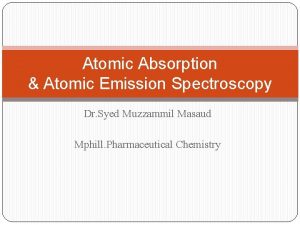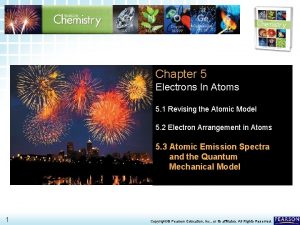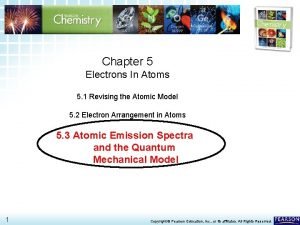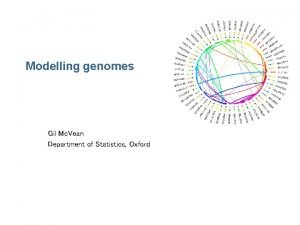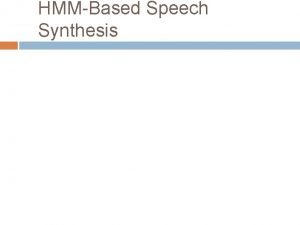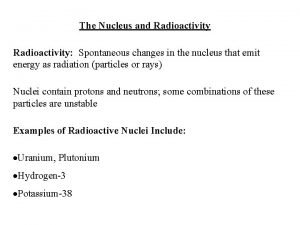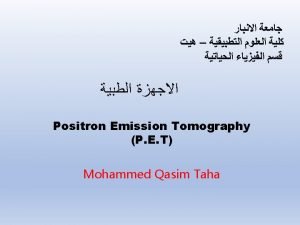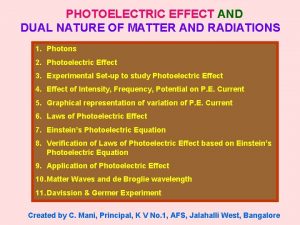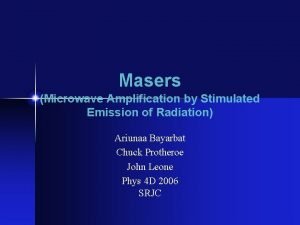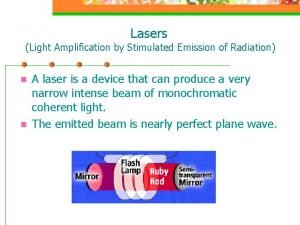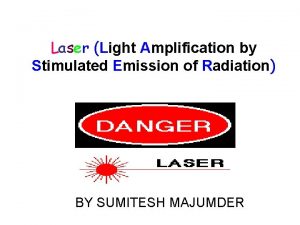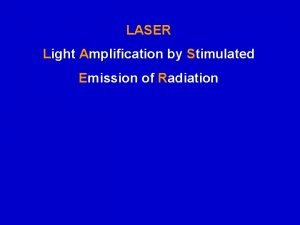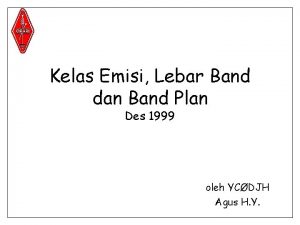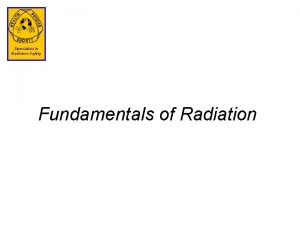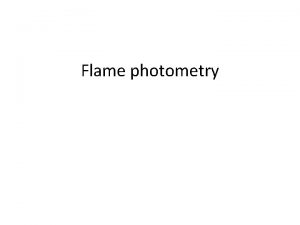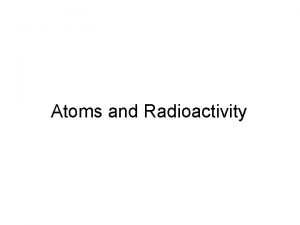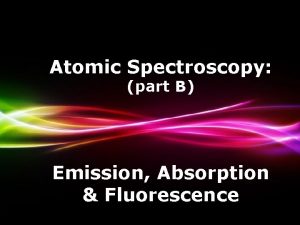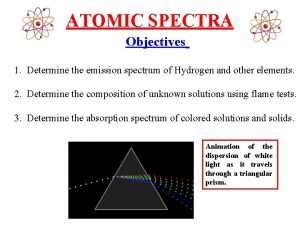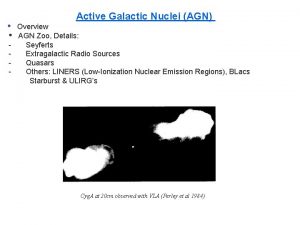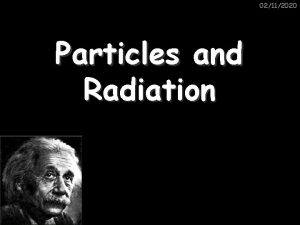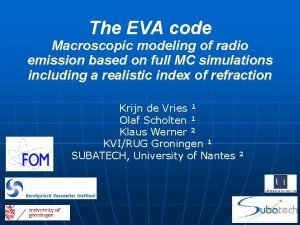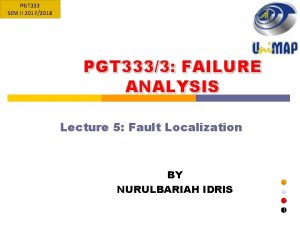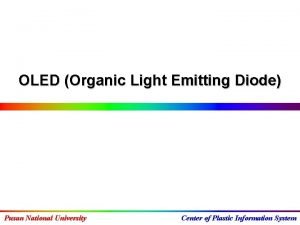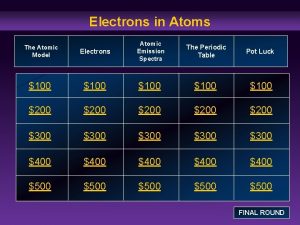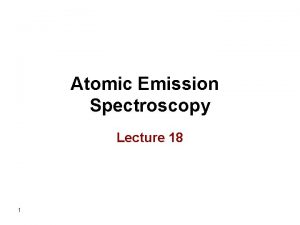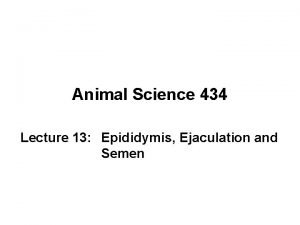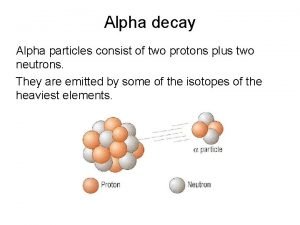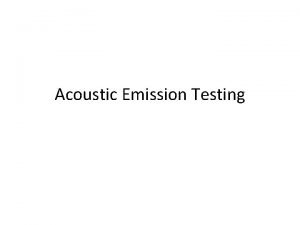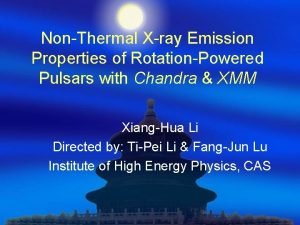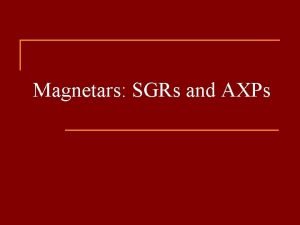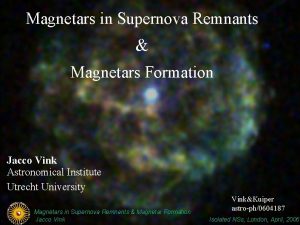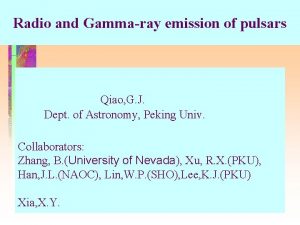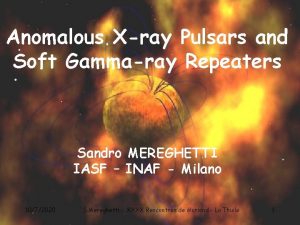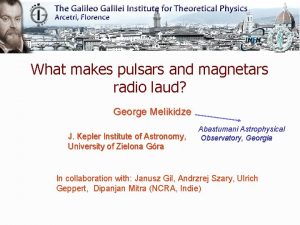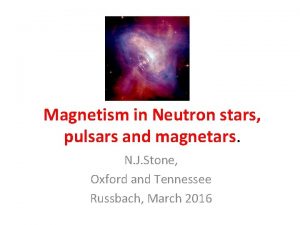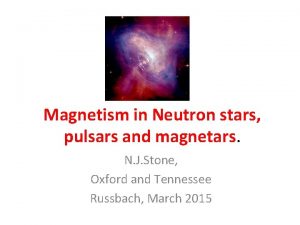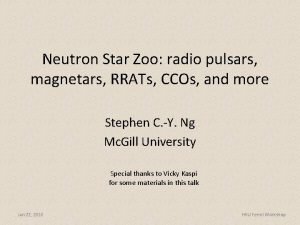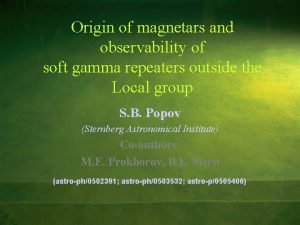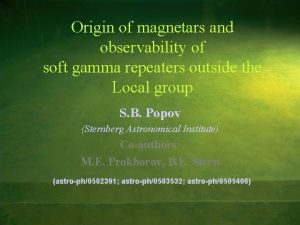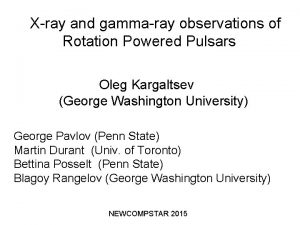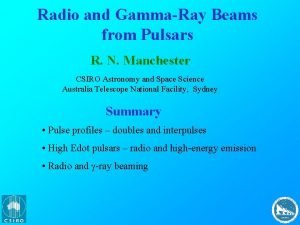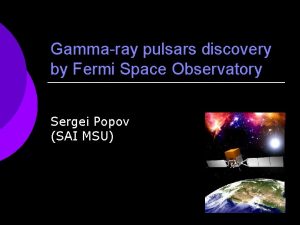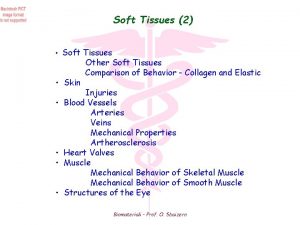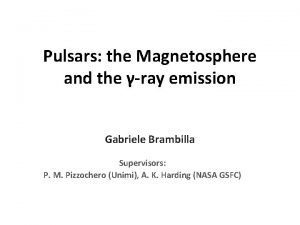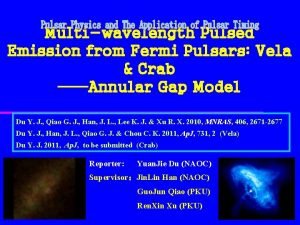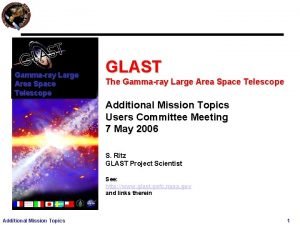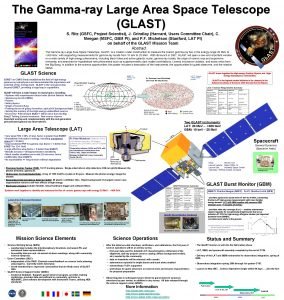Soft gammaray emission from rotationpowered pulsars and magnetars



































- Slides: 35

Soft gamma-ray emission from rotationpowered pulsars and magnetars: status and observational requirements for constraining the physics in neutron-star magnetospheres Wim Hermsen SRON & Astronomical Institute “Anton Pannekoek”, University of Amsterdam

Challenges radio pulsars and magnetars: • How do magnetars form? • What is Equation of State? • What are the physical processes in the magnetic field near neutron star where magnetic field can reach above the QED limit (strong B-field pulsars, magnetars)? • What are scenario's, production processes of radio, IR, optical, soft X-ray, hard X-ray, gamma-ray emissions in persistent emissions, bursts, outbursts? • What is the connection between the radio-pulsar and magnetar population ? • What is the role of the magnetic field? W. Hermsen, Me. V domain, Paris 16 Jan. 2013 2

• Magnetars W. Hermsen, Me. V domain, Paris 16 Jan. 2013 3

AXP / SGR Hosts P (s) 4 U 0142+61 8. 69 RXS J 1708 -4009 10. 99 1 E 1841 -045 Kes 73 11. 77 1 E 2259+586 CTB 109 6. 98 CXO J 0100 -72 in SMC 8. 02 1 E 1048 -5937 6. 4 1 E 1547 -5408 G 327 -0. 13 2. 0 XTE 1810 -197 5. 5 CXO 1647 -4552 in Wes 1 10. 61 CXO 1714 -3810 CTB 37 B 3. 82 SGR 1900+14 OB 5. 17 SGR 1806 -20 OB 7. 55 SGR 0526 -66 in LMC 8. 05 SGR 1627 -41 2. 59 SGR 0501+4516 5. 76 SGR 1833 -0832 7. 56 AX J 1845 -0258 G 29. 6+0. 1 6. 97 SGR 0418+5729 9. 08 PSR 1622 -4950 G 333. 9+0. 0? 4. 32 Swift J 1822. 3 -1606/SGR 1822 8. 44 Swift J 1834. 9 -0846 W 41 2. 48 B (1014 G) 1. 3 4. 7 7. 1 0. 5 3. 9 2. 2 2. 9 1. 3 4. 8 6. 5 18 7. 3 2. 2 2. 0 1. 8 <0. 075 2. 8 0. 28 1. 4 comments (O=opt, I=IR) hard X-rays, O, I hard X-rays transient/ hard X-rays, O, I transient, O outbursts/radio/ hard X-rays, I transient/radio, O outburst GF/ hard X-rays /outbursts GF/ hard X-rays /outburst, I, QPO GF outburst/ transient hard-X, O outburst transient , candidate outburst transient, radio, extremely variable transient, discovered 14 July 2011 transient, discovered 7 August 2011 W. Hermsen, Me. V domain, Paris 16 Jan. 2013 4

PSR 1622 -4950 AXP 1 E 1547 -5408 Increasing diversity PSR 1846 -0258 SGR 0418+5729; a waning magnetar, Bp ≤ 7. 5 x 1012 G, age ≈ 1 Myr ? (Turolla et al. 2011) Swift J 1822. 3 -1606 SGR 0418+5729 PSR 1622 -4950; discovered as a radio pulsar (Levin et al. 2010), X-ray outburst (Anderson et al. 2012) Rea PSR 1846 -0258; young, high B-field, radio-quiet, rotation-powered neutron star, exhibited during 60 days SGR-like behavior (outburst, bursts) (Gavrill et al. 2008), (Kuiper & Hermsen 2009) Swift J 1822. 3 -1606; new low B-field magnetar; Bp = 2. 8 x 1013 G (Rea et al. 2012), (Kuiper & Hermsen 2011) AXP 1 E 1547 -5408; first magnetar with pulsations discovered in the radio band (Camilo et al. 2007). First time outburst and decay at hard X-rays after timing glitch (Kuiper, Hermsen, den Hartog, Urama, 2012) W. Hermsen, Me. V domain, Paris 16 Jan. 2013 5

Connection with radio pulsar population ? Peculiar properties of magnetar radio emission: 1) Delay appearance radio after X-ray outburst 2) Variable pulse profiles and radio flux on times scales minutes to days 3) Decay of average radio flux with X-ray outburst decay 4) Flat radio spectrum over wide range of ν's, α~0 Rea, Pons, Torres, Turolla, 2012 These properties at variance with those of high B-field radio pulsars, Bp ~(5 -9) x 1013 G W. Hermsen, Me. V domain, Paris 16 Jan. 2013 6

Persistent hard X-ray/soft gamma-ray emission Detected sources: AXP 1 E 1841 -045 AXP 1 RXS J 1708 -4009 AXP 4 U 0142+614 AXP 1 E 1547. 0 -5408 (transient hard X-ray emission) AXP 1 E 2259+586 SGR 1900+14 (Götz et al. 2006) SGR 1806 -20 (Mereghetti et al 2005; Molkov et al. 2005) SGR 0501+4516 (transient hard X-ray emission) W. Hermsen, Me. V domain, Paris 16 Jan. 2013 7

FERMI-GBM detections of pulsed emission up to 300 ke. V persistent Curves are fits to INTEGRAL profiles, persistent emission stable over ~10 yrs Verbeek, Kuiper, Hermsen, 2013 persistent during outburst W. Hermsen, Me. V domain, Paris 16 Jan. 2013 8

1 E 1841 -045 1 RXS J 1708 -4009 Total and Pulsed high-energy spectra of persistent AXPs Pulsed fluxes from FERMI-GBM up to 300 ke. V 4 U 0142+614 New: pulsed fractions at ~100 ke. V 25 -40% ! Pulsed emission: Spectral break or bend around 100 ke. V required for 4 U + 1 E W. Hermsen, Me. V domain, Paris 16 Jan. 2013 10

Anomalous X-ray Pulsars are hard X-ray sources!!! Spectra pulsed emission: 3 radio pulsars 3 AXPs _ total _ pulsed Sensitivity 30 x Comptel seems sufficient Fermi LAT? (Kuiper et al. 2006) E (Me. V) W. Hermsen, Me. V domain, Paris 16 Jan. 2013 11

4 U 0142+614: time-averaged total high-energy spectrum Rea et al 2008, den Hartog et al. 2008, Kuiper et al. 2006, Abdo et al. 2010 For Fermi-LAT analysis on 4 U 0142+61, see also Muş & Gőğű, 2010 W. Hermsen, Me. V domain, Paris 16 Jan. 2013 13

Transient magnetar 1 E 1547. 0 -5408 seen by Fermi/GBM after glitch 1 E 1547. 0 -5408 Spectral shapes at peak of outburst similar to those of persistent emission of AXP's W. Hermsen, Me. V domain, Paris 16 Jan. 2013 14

Anomalous X-ray Pulsars are hard X-ray sources!!! 1 E 1547. 0 -5408 at peak outburst (~80 days): Total emission Pulsed emission _ _ (Kuiper et al. 2006) E (Me. V) W. Hermsen, Me. V domain, Paris 16 Jan. 2013 15

Some production scenarios for persistent soft γ-ray emission 1) Bremstrahlung photons produced in thin layer close to neutron star. cutoff energy at ~100 ke. V (Beloborodov & Thompson 2007) 2) Magnetic Compton up-scattering of soft X-ray photons by non-thermal population of highly relativistic electrons, up to 20 Me. V (? ) (Baring & Harding 2007) 3) Secondary pairs in the closed-field-line region producing synchrotron radiation at ~100 km above the star (Thompson & Beloborodov 2005) 5) Multipolar force-free magnetospheres, with resonant upscattering including also highly relativistic electrons (Pavan et al. 2009) Crucial. None for the is: explains ofinterpretation these models How do spectra extrapolate above few 100 ke. V ! allthe observed characteristics W. Hermsen, Me. V domain, Paris 16 Jan. 2013 16

Soft γ-ray production in activated magnetic loops that extend to radii ≥ 5 RNS Beloborodov 2012 radiative zone "j-bundle" B>1013 G adiabatic zone Upscattered photons of energy Spectra for axisymmetric j-bundle, E ~ γ 2 Et are beamed along adiabatic observed at different angles relativistic outflow (along closed field w. r. t. magnetic axis lines, similar to outflow along open field lines in ordinary pulsars) W. Hermsen, Me. V domain, Paris 16 Jan. 2013 17

Soft γ-ray production in magnetic loops that extend to radii ≥ 5 RNS Beloborodov 2012 phase averaged pulsed Orthogonal rotator, α=90 o , j-bundle symmetric about B-axis j-bundle not axisymmetric Additional processes at other sites in magnetosphere also possible W. Hermsen, Me. V domain, Paris 16 Jan. 2013 18

Production sites unpulsed soft γ-ray emission? (Nobili) (Nobili 2009) W. Hermsen, Me. V domain, Paris 16 Jan. 2013 19

• Rotation-powered pulsars W. Hermsen, Me. V domain, Paris 16 Jan. 2013 22

High-energy g-ray (>100 Me. V) pulsar population 2 nd Fermi LAT Pulsar Catalogue: # 117 Preliminary Radio-loud : 41 Radio quiet: 36 Ms pulsars : 40 Young pulsars: 77 Maximum luminosity at Ge. V energies W. Hermsen, Me. V domain, Paris 16 Jan. 2013 23

Hard X-ray/soft g-ray pulsar population (> 20 ke. V): 15 members W. Hermsen, Me. V domain, Paris 16 Jan. 2013 24

Hard X-ray/soft g-ray pulsar characteristics Spectral view (1 ke. V – 10 Ge. V) Profile morphology: Single sharp pulse : #2 Two (sharp) pulses : #3 (All LAT) Multiple sharp : #1 (Vela; LAT) Single (structured) : #9 (1509 -58; LAT) broad pulse 1509 -58 AX J 1838. 0 -0655 0205 -6449 1846 -0258 IGR J 18490 -0000 2229+6114 Maximum luminosity at Me. V energies! W. Hermsen, Me. V domain, Paris 16 Jan. 2013 25

35. 70 +/- 1. 05 37. 46 +/- 0. 66 Source counts High-energy (FERMI) population: grey Spin-down luminosity (non-recycled) Soft γ-ray population: black Soft γ pulsars ~60 x more energetic 'Absolute' numbers Characteristic age/time scale 3. 78 +/- 0. 52 4. 80 +/- 0. 76 Soft γ pulsars ~10 x "younger" W. Hermsen, Me. V domain, Paris 16 Jan. 2013 26

Decoupling pulsed/DC spectra ➞ underlying PWN spectrum! Total emission from AX J 1838. 0 -0655 PWN spectrum bends above ~50 ke. V Suzaku XIS 0. 7 -10 ke. V (42. 2 ks): G=1. 27± 0. 11; Anada et al. (2009) INTEGRAL ISGRI 20 -300 ke. V : G=1. 72± 0. 07; this work; consistent with Malizia et al. (2005) W. Hermsen, Me. V domain, Paris 16 Jan. 2013 27

PSR J 1846 -0258 PSR J 1811 -1925 W. Hermsen, Me. V domain, Paris 16 Jan. 2013 28

Magnetar-like fenomena from PSR J 1846 -0258 in Kes 75 > outburst, bursts < Linking RPPs ⇔ magnetars (? ) Brightening, 2 -10 ke. V: ~6 x CXO Oct. 15 -16, 2000 CXO June 5, 7 -8, 9, 12 -13, 2006 Kumar & Safi-Harb 2008, Gavriil et al. 2008 W. Hermsen, Me. V domain, Paris 16 Jan. 2013 29

Characteristics during outburst (Kuiper & Hermsen 2009) This major glitch triggered the outburst INTEGRAL obs. RXTE obs. Pulsed emission W. Hermsen, Me. V domain, Paris 16 Jan. 2013 30

High-energy spectrum of PSR J 1846 -0258 was for a short period “AXP-like”, but L remained <Lspindown Role B-field ? W. Hermsen, Me. V domain, Paris 16 Jan. 2013 31

Pulsar models - Vacuum dipole field - Force-free magnetosphere e. g. with annular gap model (Spitkovsky) W. Hermsen, API-HEA, 8 October 2012

Vacuum gap models Ruderman & Sutherland (1975): • A vacuum gap is formed above the polar cap because of impossibility of pulling ions from the neutron star surface: significant potential drop • Gap is constantly breaking down due to pairproduction discharges: "sparks" • These sparks correspond to regions called subbeams, which supply the particles generating the radio emission • Positrons move outward along curved magnetic field lines, produce radio emission • Backflow of electrons, heating the surface to T>106 K: thermal X-rays • Subbeams rotating around magnetic axis under the action of Ex. B drift W. Hermsen, API-HEA, 8 October 2012

Space-charge limited flow models Arons & Scharlemann (1979), Jones (1986), Harding et al. (2002): • Surface charges can freely flow into the magnetosphere • Inner gap above polar cap is thought to be space charge limited • Polar cap much less heated due to very much smaller return current: much less thermal X-rays, possibly mainly non-thermal X-rays W. Hermsen, API-HEA, 8 October 2012

Synchronous X-ray and Radio Mode Changing in a Pulsar: Evidence for a Rapid Global Transformation of the Magnetosphere W. Hermsen 1, 2, J. W. T. Hessels 3, 2, L. Kuiper 1, J. van Leeuwen 3, 2, D. Mitra 4, J. de Plaa 1, J. M. Rankin 2, 5, B. Stappers 6, G. A. E. Wright 7 and LOFAR Team 1 SRON Netherlands Institute for Space Research 2 Astronomical Institute "Anton Pannekoek", University of Amsterdam 3 ASTRON Netherlands Institute for Radio Astronomy 4 National Centre for Radio Astrophysics, Ganeshhkind, Pune, India 5 Physics Department, University of Vermont, Burlington, USA 6 Jodrell Bank Center for Astrophysics, Manchester, UK 7 Astronomy Centre, University of Sussex, Falmer, Brighton, UK Science, January 25, 2013 W. Hermsen, Me. V domain, Paris 16 Jan. 2013 35

REQUIREMENTS • Sensitivity: >~ 30 x COMPTEL • Timing accuracy better than 50 μs (msp) • Good spatial resolution important to avoid source confusion for measuring total emission in sky maps (unpulsed emission from magnetars; PWN emission around pulsars) • Energies, down to ~100 ke. V for PWNe • Modest spectral resolution W. Hermsen, Me. V domain, Paris 16 Jan. 2013 36

Spin-down Powered millisec Pulsars: ● Old, low B pulsars < 10 ke. V up to ~20 ke. V ● 7 systems show pulsed X-ray emission ● 2 sub-classes: I – 4 have broad pulses soft spectra low luminosity (pulsed ~ 1030 erg s-1) (seen because “nearby”) II – 3 have narrow pulses hard spectra up to ~20 ke. V high luminosity (pulsed ~ 1032 erg s-1) + PSR J 2124 -3358 Zavlin 2005 37

Spin-down Powered millisec Pulsars, Class II High-energy spectra Kuiper & Hermsen 2003 X-ray Photon spectral indices ~1. 0 PSR 0218+4232 seen by EGRET up to 1 Ge. V! 38

PSR J 0437 -4715 Profiles of millisecond pulsars X-ray peaks (mostly) in phase with radio peaks PSR J 0218+4232 (Similar to Crab) PSR B 1821 -24 PSR B 1937+21 X-Ray Radio 39
 Difference between absorption and emission spectrum
Difference between absorption and emission spectrum Atomic emission spectra and the quantum mechanical model
Atomic emission spectra and the quantum mechanical model Atomic emission spectra and the quantum mechanical model
Atomic emission spectra and the quantum mechanical model Emission and absorption spectra grade 12
Emission and absorption spectra grade 12 Tga vean
Tga vean Transition and emission probability
Transition and emission probability Positron emission equation
Positron emission equation What is the symbol for an alpha particle
What is the symbol for an alpha particle Positron emission
Positron emission Einstein equation for photoelectric emission is
Einstein equation for photoelectric emission is Masers are microwave
Masers are microwave Light amplification by stimulated emission of radiation
Light amplification by stimulated emission of radiation Properties of laser light
Properties of laser light Spontaneous emission
Spontaneous emission Class of emission
Class of emission Bread toasting: gas formation color change light emission
Bread toasting: gas formation color change light emission Beta minus decay
Beta minus decay Researchgate
Researchgate Principle of flame test
Principle of flame test Gamma emission equation
Gamma emission equation Atomic absorption spectrophotometer ppt
Atomic absorption spectrophotometer ppt Beilstein test
Beilstein test Atomic emission spectroscopy principle
Atomic emission spectroscopy principle Emission vs ejaculation
Emission vs ejaculation Miller zoo emission
Miller zoo emission Absorption vs emission
Absorption vs emission Lepton number table
Lepton number table Radio emission codes
Radio emission codes Photo emission microscopy failure analysis
Photo emission microscopy failure analysis Oled top emission
Oled top emission Atomic emission spectra periodic table
Atomic emission spectra periodic table Cispr 22 radiated emission limits
Cispr 22 radiated emission limits Photometry
Photometry Emission vs ejaculation
Emission vs ejaculation Plutonium-239 alpha decay equation
Plutonium-239 alpha decay equation Acoustic emissions testing
Acoustic emissions testing
